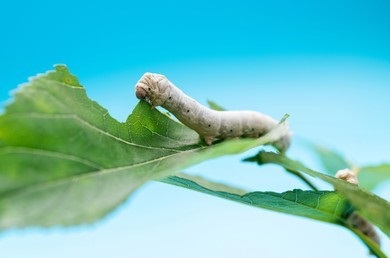The silkworm (Bombyx mori) is an insect of the order Lepidoptera, one of the economic insects that feed on mulberry leaves and spits cocoons, and is a major source of raw material for silk, which has important economic benefits. In addition to being used in clothing and textiles, it is also used in medicine, beauty care, and as a high-quality biomaterial for human beings.

As a recognized "queen of fibers", silk has a graceful and elegant luster, light and comfortable touch, good draping and curvature of clothing, high breathability and moisture permeability, and affinity to human skin and other fiber properties, so it has been classified as a high-end textile fiber material.
Silkworm is the earliest economic insect to be domesticated and reared artificially. The silkworm has a short life cycle, fast growth rate, suitable for mass rearing, and a clear genetic background, and is also an important lepidopteran model insect for functional gene analysis in the post-genomic era.
Lifeasible has used genome-targeted editing technologies (CRISPR/Cas9) to manipulate the silkworm genome, including targeted mutation knockout of endogenous and exogenous genes, genome structural mutation, and targeted integration of exogenous genes in the silkworm genome.
Our knockout mutant silkworm models established by CRISPR/Cas9 genome manipulation have been widely used in various fields such as functional analysis and identification of unknown endogenous genes in the silkworm, the study of silk synthesis and secretion mechanism, the study of hormonal regulation of metamorphosis development, the study of sex regulation and development of transgenic silk gland bioreactor in silkworm.
| TALENs | CRISPR/Cas9 |
|
|
Gene editing strategy
By the forward genetic targeting cloning method, the wild-type silkworm was used as the material, and Lifeasible knocked out the target gene by targeted mutation using genome targeting editing technology, and the phenotypic changes were compared with the natural mutant to verify the accuracy of the targeting cloning.
After screening the silkworm genome for endogenous genes whose functions have not been fully resolved or silkworm direct homologs of identified functional genes from other insect species (usually Drosophila) as targets by information analysis, Lifeasible uses genome targeted editing technology to create target gene knockout mutants in silkworm, and subsequently studies and analyzes the function of the target gene by examining the phenotypic and trait changes in the knockout mutant individuals.
Lifeasible can create new mutant silkworm breeds with specific genetic and phenotypic differences by knocking out certain endogenous genes whose functions are already well defined through targeted mutations.
Lifeasible uses genome targeted editing technology to mediate GSVs such as deletions, inversions, and translocations of large segments of genomic DNA sequences while performing targeted mutagenesis operations on two or more target loci.
Lifeasible provides homologous recombination technology to cause double-strand breaks at specific sites in the silkworm genome. Using DSB repair mechanisms such as NHEJ or HR to knock-in foreign genes at specific points, CRISPR/Cas9 system is also applied to establish a precise integration into target chromosome system foreign gene integration strategy, so as to realize the site-specific integration of the foreign gene coding region of the silkworm gene.
Lifeasible can achieve site-directed mutation knockout of foreign genes through the CRISPR/Cas9 system. At the same time, we can provide the tBE base editing system according to the customer's sample situation, and realize direct and reversible DNA base replacement without cutting the DNA.

We offer complete, professional silkworm gene editing services, as well as customized experimental protocols based on your project requirements and sample characteristics. For more information or any inquiry requirements, please contact Lifeasible.
References:
Lifeasible has established a one-stop service platform for plants. In addition to obtaining customized solutions for plant genetic engineering, customers can also conduct follow-up analysis and research on plants through our analysis platform. The analytical services we provide include but are not limited to the following:
Get Latest Lifeasible News and Updates Directly to Your Inbox
Mechanism of Action of Plant Resistosome NRC4
May 20, 2025
Mechanisms Regulating Plant Chloroplast Biogenesis
April 15, 2025